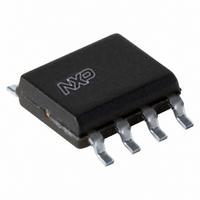PCF85102C-2T/03,11 NXP Semiconductors, PCF85102C-2T/03,11 Datasheet - Page 16

PCF85102C-2T/03,11
Manufacturer Part Number
PCF85102C-2T/03,11
Description
IC EEPROM 2KBIT 100KHZ 8SOIC
Manufacturer
NXP Semiconductors
Datasheet
1.PCF85102C-2T0311.pdf
(20 pages)
Specifications of PCF85102C-2T/03,11
Memory Size
2K (256 x 8)
Package / Case
8-SOIC (3.9mm Width)
Format - Memory
EEPROMs - Serial
Memory Type
EEPROM
Speed
100kHz
Interface
I²C, 2-Wire Serial
Voltage - Supply
2.5 V ~ 6.0 V
Operating Temperature
-40°C ~ 85°C
Organization
256 K x 8
Interface Type
I2C
Maximum Clock Frequency
0.1 MHz
Supply Voltage (max)
6 V
Supply Voltage (min)
2.5 V
Maximum Operating Current
2 mA
Maximum Operating Temperature
+ 85 C
Mounting Style
SMD/SMT
Minimum Operating Temperature
- 40 C
Operating Supply Voltage
3.3 V, 5 V
Lead Free Status / RoHS Status
Lead free / RoHS Compliant
Lead Free Status / RoHS Status
Lead free / RoHS Compliant, Lead free / RoHS Compliant
Other names
935262037118
PCF85102C2D-T
PCF85102C2D-T
PCF85102C2D-T
PCF85102C2D-T
Philips Semiconductors
9397 750 14216
Product data
14.3.2 Wave soldering
14.3.3 Manual soldering
Moisture sensitivity precautions, as indicated on packing, must be respected at all
times.
Conventional single wave soldering is not recommended for surface mount devices
(SMDs) or printed-circuit boards with a high component density, as solder bridging
and non-wetting can present major problems.
To overcome these problems the double-wave soldering method was specifically
developed.
If wave soldering is used the following conditions must be observed for optimal
results:
During placement and before soldering, the package must be fixed with a droplet of
adhesive. The adhesive can be applied by screen printing, pin transfer or syringe
dispensing. The package can be soldered after the adhesive is cured.
Typical dwell time of the leads in the wave ranges from 3 to 4 seconds at 250 C or
265 C, depending on solder material applied, SnPb or Pb-free respectively.
A mildly-activated flux will eliminate the need for removal of corrosive residues in
most applications.
Fix the component by first soldering two diagonally-opposite end leads. Use a low
voltage (24 V or less) soldering iron applied to the flat part of the lead. Contact time
must be limited to 10 seconds at up to 300 C.
When using a dedicated tool, all other leads can be soldered in one operation within
2 to 5 seconds between 270 and 320 C.
•
•
•
•
below 240 C (SnPb process) or below 260 C (Pb-free process) for packages with
a thickness < 2.5 mm and a volume < 350 mm
Use a double-wave soldering method comprising a turbulent wave with high
upward pressure followed by a smooth laminar wave.
For packages with leads on two sides and a pitch (e):
The footprint must incorporate solder thieves at the downstream end.
For packages with leads on four sides, the footprint must be placed at a 45 angle
to the transport direction of the printed-circuit board. The footprint must
incorporate solder thieves downstream and at the side corners.
– for packages with a thickness
– for packages with a thickness < 2.5 mm and a volume
– larger than or equal to 1.27 mm, the footprint longitudinal axis is preferred to be
– smaller than 1.27 mm, the footprint longitudinal axis must be parallel to the
thick/large packages.
parallel to the transport direction of the printed-circuit board;
transport direction of the printed-circuit board.
Rev. 04 — 22 October 2004
256
2.5 mm
8-bit CMOS EEPROM with I
3
so called small/thin packages.
© Koninklijke Philips Electronics N.V. 2004. All rights reserved.
PCF85102C-2
350 mm
2
C-bus interface
3
so called
16 of 20
















